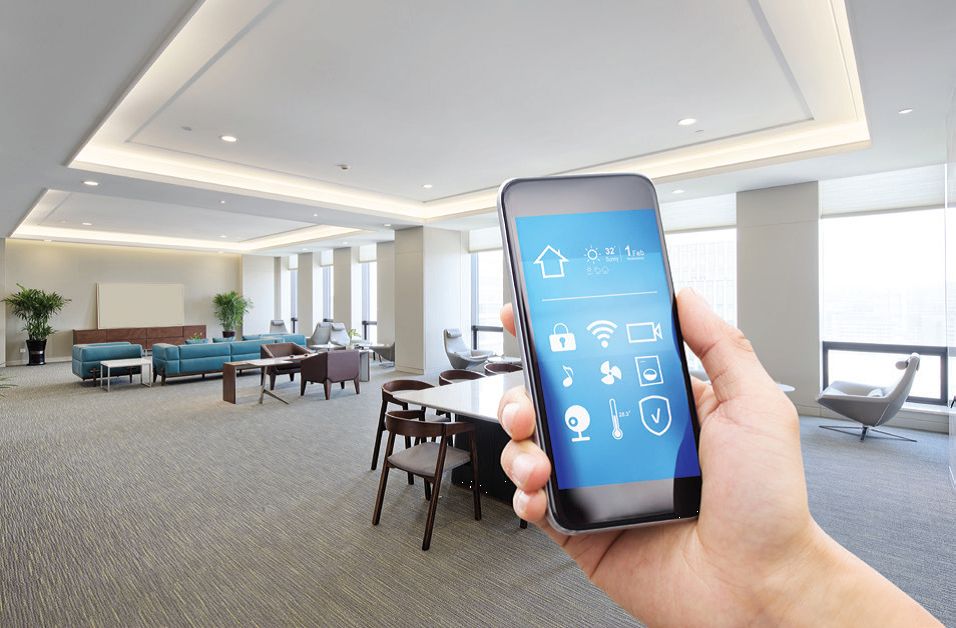
Ask Roger Karner, head of U.S. operations for Signify, if distributors are facing a critical juncture in their approach to selling lighting and he won’t hesitate to answer. “We’ve reached an inflection point in the evolution of lighting and the transformation of the lighting industry where a decision must be made,” he said. “Either get connected or get commoditized.”
With current lighting technology enabling not only greater controllability of lighting but also entrée to access points which allow the connectivity of other building systems, distributors are encouraged to understand the opportunities in this space and get ahead of them to ensure their long-term success. In the following article, a range of sales and marketing executives from leading lighting manufacturers share insights on the state of connected lighting technology and how distributors can capitalize on these systems to add value and stand out in today’s increasingly digital lighting environment.
ENDLESS POSSIBILITIES
“They’ll always be a market for selling one-to-one replacements in LED lighting, but the end user is getting increasingly educated around the connected space,” said Sero Cardamone, senior vice president of global sales at Acuity Brands. “Energy savings are expected and it’s now about what else the system can do; in that sense, the lighting network is a great vehicle to connect your entire indoor and outdoor space.” In fact, he said, “the fastest-growing part of our business has been sales of our network control system, which has been growing rapidly over the past five years. We see adoption rates accelerating as systems continue to extend to other parts of the building envelope.”
“There’s no question that the connected world of lighting is upon us and it’s very important for distributors to stay ahead,” agreed Matt McCarron, vice president of commercial sales at LEDVANCE. “It seems like today the volume movers are in a ‘race to the bottom.’ We saw this a few years ago with A-line technology, last year with TLEDs and now this year with flat panels; the electrical distributor’s only way to avoid this degradation is through innovation and smart, connected solutions are providing some of that.”
Thomas Scherzer, North American channel executive at Current, Powered by GE, wholeheartedly agreed that distributors need to be prepared to market and sell connected lighting solutions in today’s increasingly digital marketplace. “As the demand for smarter homes and commercial buildings increases, end users are getting smarter and will not only demand but will expect a connected lighting solution,” said Scherzer, who believes that while the adoption rate for connected lighting to-date has been fairly slow with a penetration rate of 2 percent, it could rapidly increase to 25 percent by 2020. “Our challenge is in educating their employees and customers on which solution is best for their specific application, both today and in the long term,” he said.
“The adoption rate for connected lighting will be as fast as the whole LED transformation since LED lighting enables the easier and even more cost-effective use of connected lighting; they go hand-in-hand,” contended William Fodor, director of national sales at Hubbell Lighting. In a nutshell, he said, “connected lighting systems are poised to be the foundation of the next generation of smart buildings and an electrical distributor who’s not preparing or prepared to market and sell connected lighting solutions is ignoring a significant growth opportunity that has the potential to critically impact their business.”

UNDERSTANDING THE OPPORTUNITIES AND CHALLENGES
Our experts pointed to numerous examples of end users who have benefitted from the installation of a connected lighting system. Among those, a world-leading technology company that recently upgraded its headquarters from conventional lighting to a connected LED lighting system by Signify enjoyed not only significant energy savings but also $600,000 in annual operating savings by converging five networks (lighting, HVAC, CCTV, metering and access control) into one. “Employees additionally love having personal control of the lights above them through a smart phone app and can even find their way to a meeting room or available desk through indoor navigation enabled by technology delivered via connected lighting,” Signify’s Karner said.
In another example, a leading company with a long-term commitment to sustainability is currently implementing a system by Current, Powered by GE to improve energy management and irrigation processes, as well as lighting and power system controls, along with an app to manage HVAC, lighting and leak detection; the connected lighting system will be a key means of helping the company reduce greenhouse gas emissions 50 percent below its 2005 levels by 2020.
In yet another case, a large airport in the United States is installing an Acuity system to save money, increase lighting output, track assets such as wheelchairs and follow customers from the parking lot to the gate in an effort to communicate more effectively with them in the event of a power outage or other incident. “Through its lighting infrastructure, the system enables indoor positioning—e.g., the ability to know where everyone is—and may link to the building management system in the future,” Acuity’s Cardamone said.
Fodor shared that Hubbell Lighting was recently brought in to help develop a wireless control solution and create lighting scenes for a 30-acre automotive dealership. The non-invasive installation allowed engineers to avoid both a lengthy wiring process and the installation of relay panels while the software empowers facility managers with realtime monitoring capabilities, instant alarm notifications from faulty lighting equipment and increased network efficiency and maintenance operations–all from a smart phone or tablet. According to Fodor, “the dealership can now dim all fixtures after business hours rather than turn off roughly 50 percent of the poles, and the dealership’s security team has found the clarity of the nighttime footage to be 10 times better than before.”
While connected lighting technology is paying big dividends for these tech-savvy early adopters, the business of connected lighting can be somewhat complicated for many potential customers. “What currently hinders this market is customer knowledge around what these solutions can actually do to drive value to their building, campus and city,” Cardamone said. “Existing financial models need to be re-imagined to open the door to technology that makes people and buildings more productive.”
“Manufacturers provide various protocols that include open and closed systems and the market is still looking to find its water level as it pertains to a common protocol,” McCarron concurred. “This makes the initial investment into connected lighting confusing and holds back buyers as they wait for a common approach to emerge.”
“Connected lighting solutions offer incredible ways to use lighting as an asset, but there’s an element of risk,” Scherzer agreed. “The complexity of lighting with controls, network security and integration with IT, as well as shorter product cycles, lack of standards and local energy codes requires extensive preparation for market entry.”
For these reasons, our experts confirm that the education of distributors on the various systems available and their applications has never been more critical.

EDUCATION AND MORE EDUCATION
Signify’s Karner said that distributors have a distinct opportunity to deliver value in new ways by helping their customers navigate the gradual shift to connected lighting systems and select the right products to meet their application needs.
To help distributors achieve these goals, lighting manufacturers offer a variety of educational tools and forums, from comprehensive training programs, both in-person and online, to sessions at their dedicated lighting centers, training videos, lunch-andlearn opportunities and more.
In addition to capitalizing on manufacturer-sponsored educational opportunities, our experts confirm that leading distributors are employing other creative strategies to prepare themselves to participate in this changing market. According to Karner, digital tools are no longer the exception but the expectation. “Distributors who can leverage digital tools effectively will be able to unlock significant growth opportunities from more efficient sales processes to support marketing and demand generation,” he said. “They’re also identifying ways to capture new revenue service streams that will emerge as web-based control solutions become more commonplace, such as commissioning, remote performance management and post-service support.”
Cardamone agreed, noting that more and more leading-edge distributors are building strategies and sales/service plans around the end user, not just the contractor. “If you’re not getting to the end user, growth in this space will be limited because end users are the ones making decisions around how to use a network solution to drive their connected space,” Cardamone said.
Cardamone also shared that distributors who are winning in this market are hiring people with a controls and/or network background. “Pursuing individuals with experience in lighting and controls layouts, network layouts and commissioning is a recent phenomenon,” he said. “Distributors can creatively charge for that added value, which helps differentiate them and make them more competitive.”
Fodor agreed. “As opposed to the ‘old’ days of having a person on staff who knew how to wire wall box dimmers and some basic lighting systems, leading distributors are looking to have actual controls teams on staff and a go-to market strategy,” Fodor said. Finally, added Scherzer, “Leading distributors are partnering with trusted manufacturers that can provide relevant hardware and software solutions and an eco-system of services from design to commissioning.”
Overall, our experts agreed that there’s no better time for distributors to get on board with connected lighting systems. “Lighting will be able to capture more and more square footage,” Cardamone concluded, “and will create a system that an end user can take advantage of to drive energy savings, controllability, tracking of assets, indoor positioning and greater productivity.”